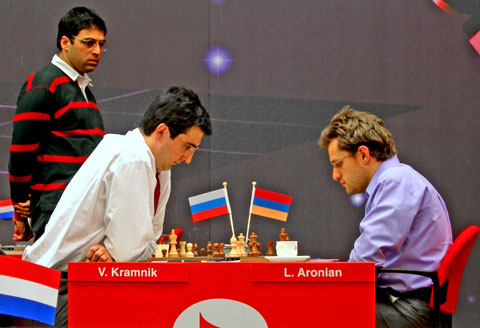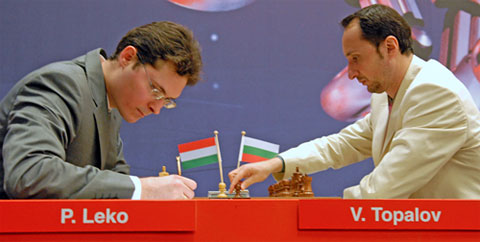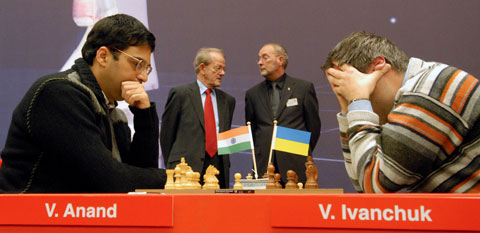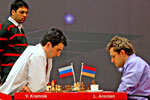Wijk aan Zee 2008

GM Mihail Marin in his analysis kitchen at home in Romania
The following express commentary was provided by Romanian grandmaster Mihail
Marin, who is the author of a number of very popular ChessBase
training CDs and articles for ChessBase Magazine. GM Marin will study the games
of the World Championship tournament in much greater detail and provide the
full results of his analysis in the next issue of ChessBase
Magazine.
Round six commentary by GM Mihail Marin
Despite three relatively short draws, this was a very interesting round, with
many spectacular moments.

The longest battle (110 moves!) was Kramnik-Aronian. It offered us an interesting
theoretical duel, culminating with a spectacular innovation by Kramnik, a complex
(but rather short) middlegame phase and another "tablebases" drawn
ending. For a while, play went along the theoretical recomendations and Aronian
managed to hold his own. However, when Kramnik displayed his forces in a way
that had not been analyzed before, the Armenian grandmaster went wrong and lost.

In Leko-Topalov a fashionable line of the Najdorf was played. The structure
became slightly unusual and, although White enjoyed certain stability, it was
mainly Black who seemed to aspire for an advantage. After the first time control,
the position simplified to a (even more) assymetrical bishop ending, with an
obvious advantage for Topalov, who went on winning.

Magnus Carlsen, the tournament leader
In Carlsen-Polgar, Black's dynamism did not prove sufficient to match White's
strategic advantage. Carlsen won two pawns and, very soon, the game.
In Mamedyarov-Eljanov White obtained a big advantage of space, but the blocked
character of the position allowed Black defend successfully. A draw was agreed
on the 66th move.

Despite a promissing start, with interesting opening play, the other three
games ended peacefully rather early.
| Group A: Round 6 - Fri. Jan. 18th |
| Loek van Wely - Boris Gelfand |
½-½ |
| Peter Leko - Veselin Topalov |
0-1 |
| Magnus Carlsen - Judit Polgar |
1-0 |
| Vishy Anand - Vassily Ivanchuk |
½-½ |
| Vladimir Kramnik - Levon Aronian |
1-0 |
| Teimour Radjabov - Michael Adams |
½-½ |
| Shak. Mamedyarov - Pavel Eljanov |
½-½ |
All pictures by courtesy of

Kramnik,V (2799) - Aronian,L (2739) [D43]
Corus A Wijk aan Zee NED (6), 18.01.2008 [Mihail Marin]
1.d4 d5 2.c4 c6 3.Nf3 Nf6 4.Nc3 e6. Aronian has included this opening
into his repertoire recently. His desire to avoid the Catalan and the g3-Queen's
Indian against Kramnik is perfectly understandable. 5.Bg5 h6 6.Bh4 dxc4 7.e4
g5 8.Bg3 b5 9.Be2 Bb7 10.0-0 Nbd7 11.Ne5 Bg7 12.Nxd7 Nxd7 13.Bd6 a6 14.a4 e5
This is the start of a very interesting sequence of moves. However, I will
not insist too much about it, since until the 24th move everything had been
played already... 15.Bg4 exd4 16.e5. For the time being, both sides ignore
the fact that the c3-knight is attacked and are more concerned about activating
their play in a way or another. 16...c5 17.Re1 Nxe5 18.Bxe5 0-0 19.Bxg7 Kxg7
Black has completed his development, retaining three pawns for a knight. The central
mass of pawns looks threatening, but the king's position is weak.
20.Ne2. Intending
Ng3, with control over the f5 and h5 squares and threats against the enemy king.
20...f5 21.Bh5 f4 Black has prevented the knight's transfer to the kingside,
but his king's position has opened even more.
22.b4 A slightly unusual
way of undermining the enemy centre.
22...cxb3 23.Qxb3 Qd5 24.Qh3 Bc8
So far, we have followed the course of the game Radjabov-Anand, Mainz (rapid)
2006. Radjabov moved with his queen to d3 and found himself under the threat of
being crushed by the black pawns. He tried to trade his knight for all the pawns,
but the tactical operation became more costly than initially planned, leading
him to the loss of an exchange and of the game. Finally, Kramnik deviates from
the previous game with the brilliant
25.Nc3!! Instead of retreating with
his attacked queen, White places a second piece en prise! The sacrificed amount
of material is not too big: White immediately gets two pawns for the knight, maintaining
strong initiative and threats on both wings, but for the human eye the aesthetical
impression is very strong. At the same time, this move becomes Fritz' 11 first
candidate, like many of Kramnik's recent novelties. By mentioning this aspect,
I do not aim to diminish Kramnik's analytical merit in any way, because it is
not at all easy to decide in which moment of a certain theoretical line the engine's
suggestion should be taken seriously...
25...dxc3. More or less forced.
Black cannot afford to retreat with his queen and allow the knight to be centralized.
26.Qxc3+ Qd4 27.Qf3 Ra7 28.axb5
White's better coordination and the weakened position of the black king offer
him an advantage despite the small material disadvantage.
28...Qf6 29.Qa3 Qb6
30.Qc3+ Kg8 31.Re5 Qf6
32.Qxc5. Slightly inaccurate. Before capturing on c5, it would have been
useful to insert 32.Qc4+!! My enthusiastic evaluation of this move is explained
by the fact that intuitively it seems better to keep the possibility of this check
in reserve for a later moment. However, concrete analysis proves that after the
previsible Qxc5, the king is best placed precisely on g8. For instance 32...Kg7
(Leaving the f8-rook undefended with
32...Kh8 would enable
33.Qxc5
Rd7 34.bxa6! when the pawn cannot be captured without losses of material.
)
33.Qxc5 Rd7 34.Rae1 axb5 35.Re6 With the king exposed on g7, White has decisive
attack. For instance, after 35...Qd8 36.Qc3+ it is impossible to cover the check
with the rook because the bishop would be lost.
32...Rd7 33.h4. By this
moment, Aronian was in time trouble already. Kramnik's last move will lead to
a promissing, but probably not winning endgame, which in fact is entirely in accordance
with his style of play. (Anticipating a bit, same applies for the final result...)
Now, 33.Rae1 axb5 is relatively safe for Black, because Black can cover his king
with ...Rg7 if necessary.; However, 33.b6!? might objectively be a better way
to maintain the tension on both wings, with reasonable chances to confuse the
opponent in a complicated middlegame.
33...gxh4 34.Bg4. Consequently heading
for a double rook endgame. White could have won an exchange more or less by force
with 34.bxa6 Bxa6 35.Bg4 Rd6 36.Rae1, when the threats Be6+ or eventually Re6
leave Black's pieces hanging. However, after 36...f3!? things are not entirely
clear, for instance 37.Be6+
(37.Bxf3 Bc8 looks acceptable for Black. At
least, he only has worries on one wing now!
) 37...Rxe6 38.Rxe6 Qg7
Analysis diagram
39.Qxf8+!! Qxf8 40.Re8 fxg2 41.Kxg2 Bc8 White will be an exchange up in the ending,
but only further analysis will prove whether his winning chances are real. Over-the-board,
this would be impossible to establish, of course, especially that reaching this
position would require accurate calculation...
34...Rdd8 35.Bxc8 Rxc8 36.Qd5+
Qf7 37.bxa6 Qxd5 38.Rxd5 Rf7 39.a7 Ra8 40.Rda5
This is the ending Kramnik had in mind. If we remove one pair of rooks (f7 and
a1) from the board, the position would be easily winning. With four rooks, White
is tied up to the defence of his passed pawn, while the f7-rook can display annoying
activity, preventing the qactivation of the white king.
40...Kh7 41.R1a3 h3!
42.gxh3 f3 43.Kh2. White cannot make any progres after 43.Kf1 Re7.
43...Rg7
44.h4 Rg2+ 45.Kh3 Rg7 46.Ra6 Rf7
47.R3a5. There was a nice help-mate available with 47.Kg4 Rg8+ 48.Kh5?
Rf5#.
47...Rg7 48.h5 Rf7 49.Kg4 Rg8+ 50.Kh3 Ra8 51.Kg4 Rg8+ 52.Rg6 Ra8
White has nothing better than transpose to a theoretically drawn rook ending,
despite White's two extra-pawns. Not something that would really bother Kramnik:
he has squeezed victories from less favourable positions...
53.Raa6 Raxa7 54.Rxh6+
Kg8 55.Rag6+ Rg7 56.Kxf3 Rxg6 57.Rxg6+ Kf7
Just three rounds after the game Radjabov-Van Wely (remember? Maizelis, Averbakh...)
we enter again the fascinating world of the tablebases. The same as in the previous
case, human analysis and evaluations made three quarters of century ago prove
entirely correct.
The first attempts to give an absolute evaluation were made in the '30s. The
analysts conclusions were contradictory in the begining. In 1930, Rudolf Spielman
stated that Black should hold a draw, but eight years later the incurable optimist
Ilya Rabinovic claimed a forced win for White. Regarding these early disputes,
Botvinnik remarked an essential drawback of the general approach. Theoreticians
tried to analyse positions where the pawns were almost on their initial positions,
which made the task unfairly difficult for the limited human powers.
In 1939 Belavenets started investigating the most favourable situation for
White, when Black's king is cut on the back rank. He correctly assesed the position
as winning and this provided other analysts with essential refference points.
This led to an analytical emulation. Soon, the positions with pawns on h6 and
f5 were practically exhausted, with the establishment of a relatively accurate
distinction between winning and drawn positions.
However, further progress on the way to the truth was made when it was discovered
that by maintaining his pawn on h5 in order to control the vital g6-square White
increases his chances for success. We shall see an illustrative case in a comment
from a more advanced stage of the game.
Keres discovered that White can confront his opponent with big practical problems
by activating his king through the empty zone on the left side of the pawns,
but his conclusion that this method would be winning is erroneous.
The first article that gave a complete and correct evaluation of the endgame
was written (not surprisingly) by Botwinnik in 1941. He proved that Black should
hold a draw if he is not forced to retreat with his king on the back rank. He
recommended for Black the following defensive system: to maintain the king on
f7 in order to prevent the activation of the white king. In case the danger
of being pushed back arises, the king should go to g7 and, if checked along
the seventh rank, to h6. This applies for the position with the h-pawn on the
fifth line; after h5-h6, the king should go to h7. The rook should stay on a1
or around it, in order to be ready to check the white king from big distance.
Sometimes, in case of concrete threats, it might be needed to move it to f1
or h1.
We are armed now with sufficient knowledge to move on.
58.Rg4 Ra1 59.Kg3 Rh1 60.Rh4 Ra1 61.Rb4 Kg7 62.Rb6 Rg1+ 63.Kf4 Rh1 64.Kg5
64...Rg1+! The only move. The neutral 64...Ra1? would allow the king to
be pushed back with 65.Rb7+ Here is an instructive line: 65...Kg8 66.f4 Rg1+ 67.Kf6
Rh1 68.f5 Rh2
(68...Rxh5 loses the rook after
69.Kg6! threatening
mate.
) 69.Rb8+ Kh7 70.Ke7 Re2+ 71.Kf7 Ra2 72.f6 Ra7+ 73.Kf8
Analysis diagram
An important moment. In the absence of the h-pawn, Black would draw with ...Kg6.
However, the h5-pawn prevents this saving move, allowing White advance hispawn
further and win the game.
65.Kf5 Rh1 66.h6+ Kh7! With the other pawn on
the second rank still, this is not the only posible move, but we can notice that
Aronian masters the theoretical material available rather well.
67.Ra6 Rf1
68.f4 Rb1 69.Re6 Ra1. Everything like in Botvinnik's defensive scenario.
70.Rf6
Re1 71.Kg4 Ra1 72.f5 Rg1+ 73.Kf4 Rf1+ 74.Ke5 Re1+ 75.Kd6. Played in accordance
with keres' plan, which, even though is not winning by force, leaves Black under
pressure.
75...Rf1 76.Ke7 Rf2 77.Rf8
77...Re2+. This move does not spoil anything, but with more time on
his clock (or more energy left) Aronian might have discovered that this was
a good moment to eliminate the h-pawn with 77...Kxh6 . Apparently, Black is
in trouble after 78.f6 but if we continue the analysis with 78...Ra2 (78...Rb2
is the same, because the distance from the enemy king is big enough.)
79.Rh8+ Kg6 80.Rg8+ we find the unexpected move 80...Kf5! which draws after
81.f7 Ra7+ 82.Kf8 (The only way to avoid immediate perpetual and the loss of
the f7-pawn) 82...Kf6 and now it is time for White to find the only saving move
83.Ke8=.
78.Kf7 Ra2. 78...Rb2 is also good, but not 78...Rc2? when the distance
separating the white king from the black rook is insufficient to allow effective
counterattack: 79.Re8 Kxh6 80.Re6+ Kh7 81.f6 Rc8 (Black has to take
the 8th rank under control whenever the enemy rooks occupies the e6-square.
After 81...Ra2 82.Kf8 Kg6 White advances his pawn with check 83.f7+
, winning an essential tempo and the game.) 82.Re8 Rc7+ 83.Ke6 Rc6+
84.Ke7 Rc7+ 85.Kd6 . Checks has come to an end and Black can resign.
79.Rd8. Botvinnik mentioned that after the activation of the king,
the white rook is best placed on d7 or e7 from practical point of view, which
justifies Kramnik's move. However, 79.Re8!? would have been trickier. Let us
see what would have happened had Aronian played as in the game: 79...Ra7+?
(79...Kxh6! is the only saving move, see the analysis below.; 79...Ra1?
80.Re6 leads to a position analyzed by Botvinnik. Here is his main line:
80...Ra7+ 81.Kf8 Ra8+ 82.Re8 Ra6 83.Re7+! Now, 83...Kxh6 allows the exchange
of rooks with 84.Re6!+. Therefore, 83...Kh8 is forced, but we shall see
that the king is exposed here, too. 84.Re6 Ra8+ 85.Re8 Ra6 86.f6! when
86...Rxf6+ loses the rook to 87.Ke7+!) 80.Kf8 Kxh6 81.Re6+ Kg5
(81...Kh7 is impossible because of 82.Re7+ In the game, such
possibilities will not exist. The d7- and d6-squares (corresponding to the similar
squares along the e-file) are not defended.) 82.f6 and Black is one tempo
too late for the saving regrouping. He would need to play ...Kg6 and ...Ra8+,
but the way it is 82...Kg6 loses to 83.f7+!
79...Ra7+. Again, Aronian misses his chance to immediately end the
game in a happy way for him with 79...Kxh6= This time, the position is "almost"
theoretical and its evaluation should have been easier to make than on the 77th
move. Here is a possible continuation: 80.f6 Ra7+ 81.Ke6 (In the absence
of the rook from the 6th rank, 81.Kf8 leads to an immeidate draw after
81...Kg6) 81...Ra6+ 82.Ke7 Ra7+ 83.Rd7 Ra8! 84.Kf7 Ra1 85.Re7 Kh7 86.Re6
Analysis diagram
I once had this position in an over-the-board game and my opponent failed to
find the only saving move, 86...Ra8! (After 86...Ra7+? 87.Kf8 he
soon resigned. The line 87...Kg6 88.f7+ is familiar to us already.)
87.Re8 Ra7+ and White cannot make further progress.
80.Kf6. Nothing really interesting will happen for a long while now,
except for the fact that Aronian probably became more and more tired. 80...Ra1
81.Rd2 Rb1 82.Ra2 Rb3 83.Rh2 Rb1 84.Rh4 Rb8 85.Kg5 Rg8+ 86.Kf4 Ra8 87.Kg5 Rg8+
88.Kf6 Ra8 89.Re4 Ra1 90.Re8 Ra2 91.Re1 Ra3 92.Rh1 Ra2 93.Kg5 Rg2+ 94.Kf4 Rf2+
95.Ke4 Re2+ 96.Kf3 Ra2 97.Ke4 Re2+ 98.Kd4 Rd2+ 99.Ke3 Ra2
100.f6. As far as I know, this setup has not been investigated by humans.
It is Kramnik's merit to have found this excellent practical chance. The far
advanced pawns are very dangerous if sustained by the rook, even if the king
is temporarily far from them. Exhausted by a long defence and with little time
left, Aronian will soon go wrong in a position that started becoming unfamiliar
to him.
100...Ra7 101.Rf1 Kg6! The only move. The passive 101...Rf7? loses
to 102.Ke4 Kg6 103.Ke5 Ra7 104.h7! (Winning an essential tempo) 104...Rxh7 105.Ke6
and Black can resign.
102.Ke4 Ra4+. From practical point of view, 102...Ra8! would have been
best, and if 103.Ke5 then simply 103...Kxh6= We can see that the control of
the back rank is esential. 104.f7 Kg7 stops the pawn while after other moves
Black can start checking.; The neutral 102...Rb7? would bring the rook too close
to the king. 103.Kd5 Rb5+ (103...Kf7 also leads to interesting play:
104.Rh1 Kg8 105.Ke6 Rb6+ 106.Kf5 Kh7 107.Rf1!? Not the only move, but
a very instructive one. The rook is placed in advance behind the pawn, anticipating
the king's departure. 107...Rb7 108.Ke6 Rb6+ 109.Kd5 Rb5+ 110.Kc6 Rb8 111.f7
Rf8 112.Kd6 winning.) 104.Kc6 Rb8 105.f7 Rf8 106.h7! (A familiar
method. White wins a tempo) 106...Kxh7 107.Kd7 and Black will lose the rook
soon. 103.Kd5
103...Kf7? The decisive mistake. With the rook on the a-file, Black has
sufficient space available to harass the enemy king with 103...Ra5+! and if 104.Kc6
then 104...Ra7! when the elimination of pawns and the perpetual check cannot be
avoided at the same time.
104.Rh1! Ra5+ 105.Kc4 Ra4+ 106.Kb5 Ra8 107.h7 Rh8
108.Rh6
White has forced his opponent to occupy passive positions with his pieces,
having defended his pawns at the same time and can safely approach with his
king. 108...Rb8+ 109.Kc6 Rc8+ 110.Kd6. A dramatical and very interesting
game in all its phases. 1-0. [Click
to replay]
Links



















































